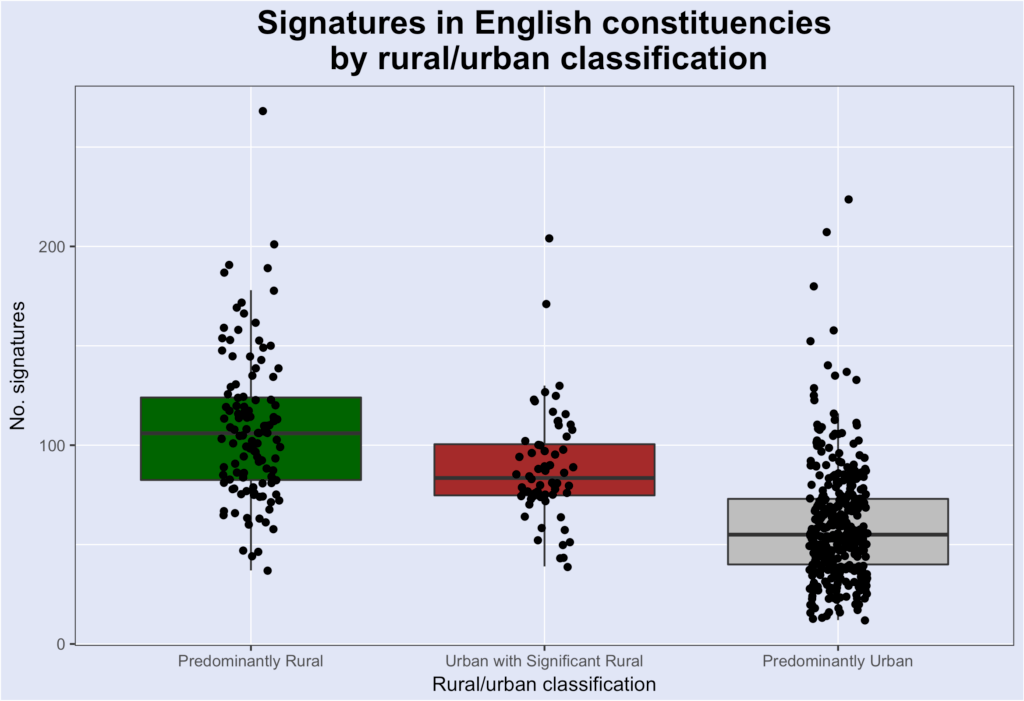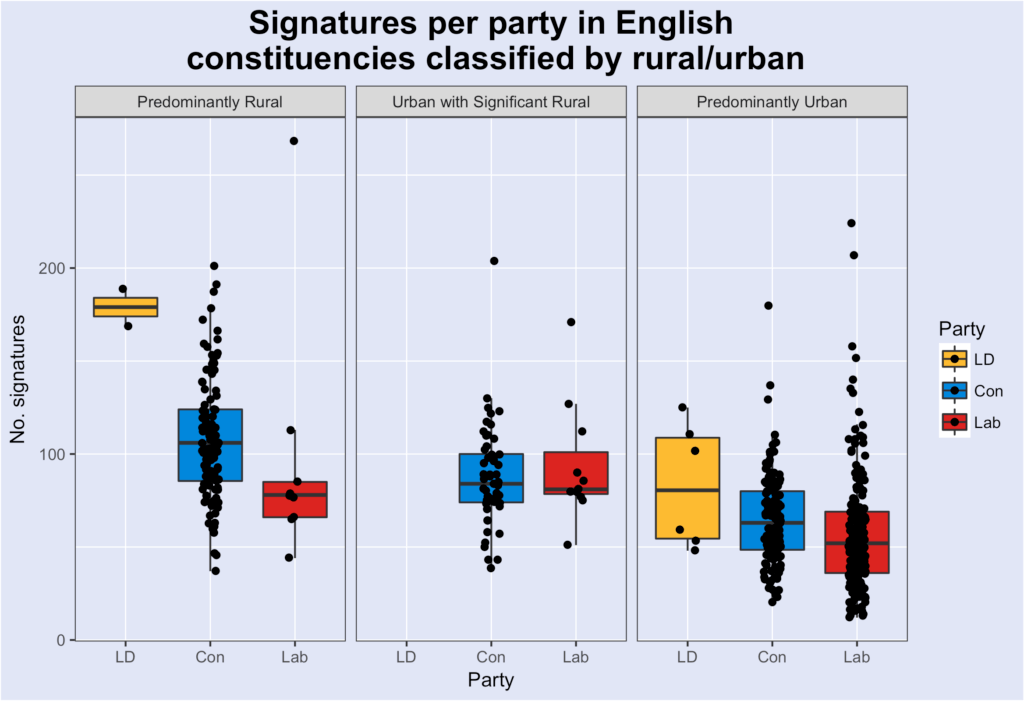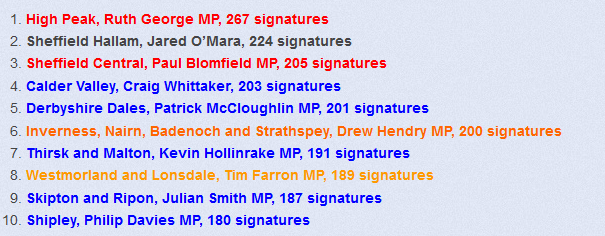

The analyses presented here (provided by ‘a reader’ – to whom many thanks) resemble closely those generated last time. They show that rural constituencies (England only was analysed) are stronger supporters of banning driven grouse shooting than are urban constituencies (with mixed urban/rural constituencies in the middle)(top graph).
We’re used to this – but it is worth remembering this graph every time someone from the Countryside Alliance says that those against some or all countryside ‘sports’ are just townies. They aren’t.
And the second graph above shows that this pattern remains true within constituencies which elected MPs from different political parties at the last (2017) general election (less convincing for Labour than Conservative and Liberal Democrat). This is interesting as there has been a turnover of who won seats and a turnover of candidates since our 2016 e-petition – but the pattern remains strong.
And who knows how far away the next general election might be.
The league table of 10 top-scoring constituencies is interesting too.

Pretty obviously, but it’s worth stressing again, these seats all either have grouse shooting within their boundaries or in neighbouring constituencies. These are areas where grouse shooting is a local issue.
High Peak must be regarded as a marginal – it was won in 2017 by Ruth George from Andrew Bingham who spoke in favour of grouse shooting in the Westminster Hall debate. Being in favour of a ban on driven grouse shooting might well be an electoral advantage in this seat (which rules out the Conservatives).
Sheffield Hallam must be regarded as a marginal too. It was lost by Nick Clegg in 2017 to a Labour candidate who then lost the Labour whip for having said unacceptable things about sexuality.
Sheffield Central is the seat that Natalie Bennett is fighting and the issue of trees being cut down in the city may be the issue most prominent in people’s minds, but not so much as to prevent this being the third Peak District regional seat in the top three constituencies supporting a ban of driven grouse shooting. The Peak District is a highly mobilised area on this subject and I’m publishing a guest blog tomorrow which highlights some very interesting news from the Peak District.
Calder Valley is definitely a marginal seat with Craig Whittaker’s majority (over Labour‘s Josh Fenton-Glynn) only 600 – Whittaker also spoke in favour of driven grouse shooting in the 2016 Westminster Hall debate.
Derbyshire Dales, Thirsk and Malton and Skipton and Ripon have strong Conservative majorities but Westmorland and Lonsdale is definitely a marginal seat with Tim Farron having a majority of only 700 or so over the Conservatives.
Inverness, Nairn, Badenoch and Strathspey is now one of the few rural Westminster seats held by the SNP after the Conservative recovery in Scotland in 2017.
In Shipley, Philip Davies lost large chunks of his majority in 2017 – it wouldn’t take a massive swing to see the seat fall to Labour.
Candidates in these constituencies might expect to be asked about their views on grouse shooting. Be prepared!
[registration_form]
In the Sheffield Central paragraph you’ve stated ” top three constituencies supporting driven grouse shooting” when I think that you mean to say ” top three constituencies supporting a ban on driven grouse shooting”. Sorry for being picky. I blame it on my job.
Shaun – you are so right. Thank you.
That is a brilliant analysis.
It shows this particular concern (serious environmental damage being caused by a ‘privileged’ few) is significantly correlated to non-urban areas.
It also shows that this particular concern weakly correlates to non-Labour constituencies.
That is why Gove is doing what he does, and why the easy assumption that Conservative politicians are anti-environment is becoming/has become out-of-date. They are, however, torn between their voters and the NFU/Countryside Alliance and their pay-masters.
Surely, Corbyn (Isllington North MP – 66 signatures) and Sue Hayman (Shadow Secretary of State for the Environment etc, Workington MP – 79 signatures) are missing a trick?
Does either actually have any real interest in the environment, other than paying it lip-service?
My one question is, regarding the breakdown by constituency party, how is Oxford West & Abingdon classified? It is a Lib-Dem constituency, which I would classify as sub-urban with significant rural, but it is not shown as such.
I certainly do not think it is predominantly urban (which the breakdown suggests).
I wonder where the analysis obtained its constituency type from?
Keith – Thank you – not at all my own work!
I can’t remember where the classification comes from but I know a man (or perhaps a woman) who does. I remember looking at it last time around. Oxford West and Abingdon is in the urban category – you can tell because it is the third highest LibDem constituency with 125 signatures (I can see the dot!). I can imagine it as being classed as urban – although it has a few fields west of Botley (!) most of the population surely live in urban ares of Abingdon, north Oxford and Kidlington – surely? – and I guess that’s what counts.
Keith,
I used the Office for National Statistics Rural/Urban classification (https://www.ons.gov.uk/methodology/geography/geographicalproducts/ruralurbanclassifications/2011ruralurbanclassification) under which Oxford West and Abingdon is classified as “Predominately urban”.
I recall the analysis of the previous petition, which also used this ONS classification, prompted a lot of discussion about the validity of this rural/urban classification but, as far as I’m aware, it’s the only national-level classification of the Westminster constituencies of this type.